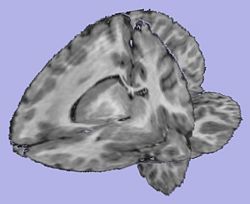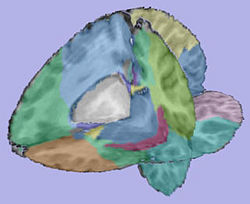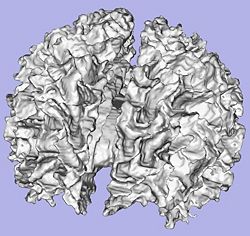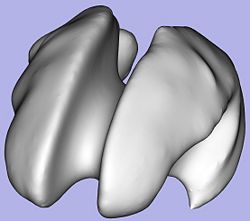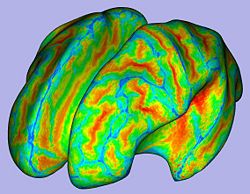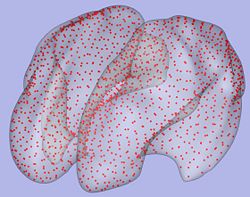Difference between revisions of "DBP2:UNC:Local Cortical Thickness Pipeline"
From NAMIC Wiki
| Line 19: | Line 19: | ||
|[[Image:SulcalDepth1.jpg|thumb|250px|Sulcal depth on original surface]] | |[[Image:SulcalDepth1.jpg|thumb|250px|Sulcal depth on original surface]] | ||
|valign="center"|[[Image:SulcalDepth2.jpg|thumb|250px|Sulcal depth on inflated surface]] | |valign="center"|[[Image:SulcalDepth2.jpg|thumb|250px|Sulcal depth on inflated surface]] | ||
| + | |valign="center"|[[Image:Particles.jpg|thumb|250px|Particles]] | ||
|} | |} | ||
</center> | </center> | ||
Revision as of 17:02, 2 March 2009
Home < DBP2:UNC:Local Cortical Thickness PipelineBack to UNC Cortical Thickness Roadmap
Objective
We would like to create an end-to-end application within Slicer3 allowing individual and group analysis of local cortical thickness.
Pipeline overview
Input: RAW images (T1-weighted, T2-weighted, PD-weighted images)
- 1. Tissue segmentation
- Probabilistic atlas-based automatic tissue segmentation via an Expectation-Maximization scheme
- Tool: itkEMS (UNC Slicer3 external module)
- 2. Atlas-based ROI segmentation: subcortical structures, lateral ventricles, parcellation
- 2.1 T1-weighted atlas deformable registration
- B-spline pipeline registration
- Tool: RegisterImages (Slicer3 module)
- 2.2. Applying transformations to the structures
- Tool: ResampleVolume2 (Slicer3 module)
- 2.1 T1-weighted atlas deformable registration
- 3. White matter map creation
- Brainstem and cerebellum extraction
- Adding subcortical structures except amygdala and hippocampus
- Tool: ImageMath (NITRC module)
- 4. White matter map post-processing
- Largest component computation
- Smoothing: Level set smoothing or weighted average filter
- Connectivity enforcement (6-connectivity)
- White matter filling
- Tool: WMSegPostProcess (Slicer3 external module)
- 5. Genus zero white matter map image and surface creation
- Tool: GenusZeroImageFilter (UNC Slicer3 external module)
- 6. White matter surface inflation
- Iterative smoothing using relaxation operator (considering average vertex) and L2 norm of the mean curvature as a stopping criterion
- Iteration stopped if vertices that have too high curvature (some extremities)
- Tool: MeshInflation (UNC Slicer3 external module)
- 6 bis(Optional). White matter image fixing if necessary
- Correction of the white matter map image (corresponding to vertices that have high curvature) with connectivity enforcement
- Tool: FixImage (UNC Slicer3 external module)
- Go back to step 5
- 7. Gray matter map creation
- Adding genus zero white matter map to gray matter segmentation (without cerebellum and brainstem)
- Tool: ImageMath
- 8. Label map creation
- Label map creation for cortical thickness computation (WM + GM + "CSF")
- Tool: ImageMath
- 9. Cortical thickness
- Asymmetric local cortical thickness or Laplacian cortical thickness
- Tool: UNCCortThick or measureThicknessFilter (UNC Slicer3 external modules)
- 10. Sulcal depth
- Sulcal depth computation using genus zero surface and inflated one
- Tool: ImageMath (NITRC module)
- 11. Cortical correspondence
- Correspondence on inflated surfaces using particle system
- Tools: ParticleCorrespondencePreProcessing, ParticleCorrespondence, ParticleCorrespondencePostProcessing (UNC Slicer3 external modules)
- 12. Group statistical analysis
- Tool: QDEC Slicer module or StatNonParamPDM
- 1. Tissue segmentation
Download
Usage
Command line execution
Step by step command line execution
Pipeline validation
Analysis on a small pediatric dataset
Tests will be computed on a small pediatric dataset which includes 2 year-old and 4 year-old cases.
- 16 autistic cases
- 1 developmental delay
- 3 normal control
Comparison to state of the art
We would like to compare our pipeline with FreeSurfer. We will thus perform a regional statistical analysis using Pearson's correlation coefficient on a pediatric dataset including 90 cases.
Two distinct groups are considered: 2 year-old cases and 4 year-old cases.
Planning
Done
- Cortical surface inflation
- Image fixing if necessary
- Sulcal depth computation
In progress
- Parameter adjustment on autism dataset to fix bad vertices
- Particle correspondence
Future work
- Workflow for individual analysis as a Slicer3 high-level module using BatchMake
- Workflow for group analysis
